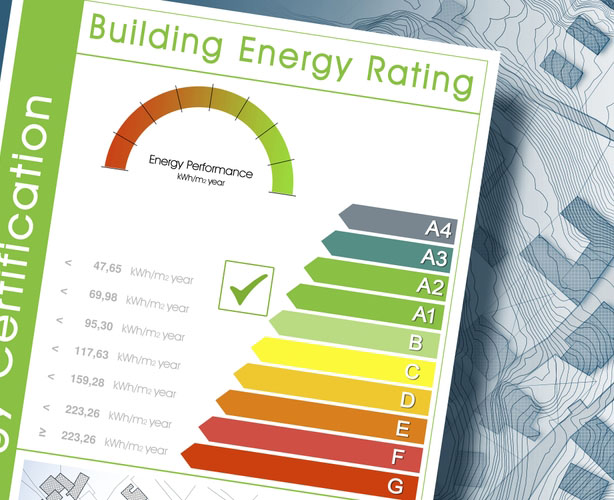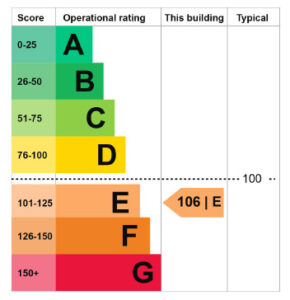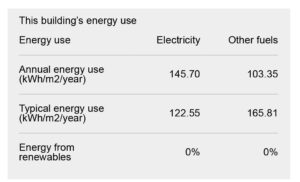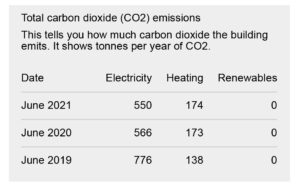
Requirements for Public Buildings in England, Wales and NI
A Display Energy Certificate (DEC) and accompanying Advisory Report is required for all public buildings in England, Wales and Northern Ireland. For a building to fall within the requirement for a DEC it must:
• be at least partially occupied by a public authority (eg council, leisure centre, college, NHS trust)
• have a total floor area of over 250 square metres
• be frequently visited by the public
As the name suggests, a DEC must be clearly displayed in a prominent place which is visible to the public (Government guidance also requires it to be no smaller than A3 in size). Failing to have a DEC or accompanying advisory report could result in a financial penalty.
The period in which a DEC is valid, depends on the total useful floor area. If it is more than 1000m² then the DEC is only valid for 1 year (The accompanying advisory report is valid for 7 years), however if it is between 250m² and 1000m² then both the DEC and advisory report is valid for 10 years.
Should you need a DEC, you can search for a DEC Assessor using our online search facility.
FIND A DEC ASSESSOR
Requirements for Public Buildings in Scotland
Unlike other regions Public Buildings are not required by law to have a DEC. That’s not to say you can’t still get a DEC as they can provide a better understanding of energy usage and can help make a case towards making changes to the building for greater energy efficiency.
In Scotland if the building is occupied by public authorities, has a floor area of 500m² or more and is frequently visited by members of the public, then the building owner will be required to obtain and display a Non-Domestic Energy Performance Certificate (EPC).
This EPC will be valid for 10 years and will need to be renewed immediately after the 10 year period has elapsed.
More information is provided on the government website.
MORE INFORMATIONWhat is a Display Energy Certificate (DEC)?
A Display Energy Certificate (DEC) is a document which details a public building’s energy use, as well as its carbon emissions.
A DEC will show the energy performance of a public building, which is presented as a sliding ‘A’ to ‘G’ scale- ‘A’ being the most efficient (low CO2 emissions) and ‘G’ being the least (High CO2 emissions).
An Advisory Report is also provided alongside a DEC. This is essentially a report of recommendations for improving the energy performance of the building.

How to find an existing DEC?
You can find a building’s DEC by searching a building’s postcode on the government’s website:
Building in England, Wales or NI: https://www.gov.uk/find-energy-certificate
Once you have found a building’s Display Energy Certificate, by selecting the ‘print’ option on the left you will be able to print a copy of the DEC which can be displayed in the building.
Building in Scotland: https://www.scottishepcregister.org.uk/
Understanding a Display Energy Certificate
On every DEC you will be able to see:
- Basic address information for the building
- When the certificate expires
- The certificate number
- Information about who did the assessment and which scheme they are accredited with
How this information is presented will change, depending on whether it is viewed online or in print.
The energy performance operational rating will be displayed as a letter at the top of the DEC and also on the coloured A to G scale.
The rating itself is based on the actual energy consumption as recorded over the last 12 months within the validity period of the DEC.
Following a DEC Assessor’s calculation a numerical score is given for the building which represents the actual annual carbon dioxide emissions from the building. This is then shown on a scale from A (lowest emissions) to G (highest emissions).
The typical score for a public building is 100. This typical score gives an operational rating of D.
You will also be able to view past operational ratings for your building.


This section shows the building’s energy use in comparison to the typical energy use of a public building.
This is provided as an annual figure in Kilowatt hours per m2. You should be able to see the amount of energy used from electricity, and other fuels. It will also show the percentage used from renewables.

This section will confirm how much carbon dioxide the building emits through electricity, heating and renewables in a year. It is displayed in tonnes of CO2 and also allows comparison with previous years.

A DEC will also be accompanied by an online Advisory/Recommendation report which identifies useful recommendations for improving the energy performance of the building.
This could include management and operational improvements, as well as installation of low or zero carbon technologies.
As mentioned above, this will be valid for 7 years.

What is involved in a DEC Assessment?
An accredited DEC Assessor will be able to provide a valid assessment of a public building. The assessment itself is carried out on site as the assessor will need to collect the following information:
• building dimensions
• energy meter readings
• building energy services
This information will be inputted into an approved software, which will produce the certificate and advisory report for the building. Following completion, your certificate and advisory report will be available to view online (a link to this should be emailed to you by your assessor). You can also print your certificate as required.
FIND A DEC ASSESSOR